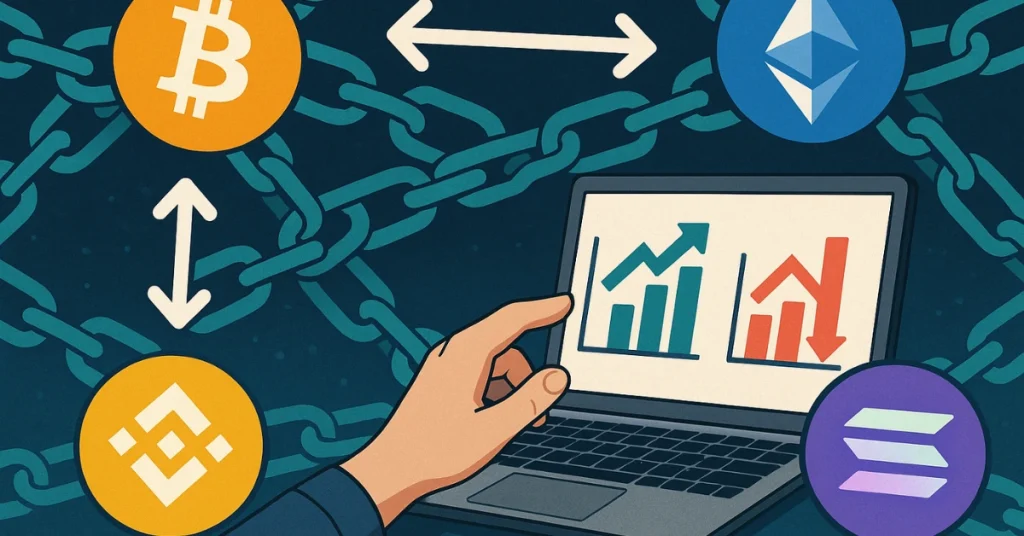How Cross-Chain Trading Layers Are Revolutionizing Crypto Market Access
0
0

The post How Cross-Chain Trading Layers Are Revolutionizing Crypto Market Access appeared first on Coinpedia Fintech News
Anyone who’s been in crypto for more than five minutes knows the pain of moving assets between blockchains. You’ve probably been there – trying to move your SOL to Ethereum or your MATIC to Binance Smart Chain, only to face a confusing mess of exchanges, wallet addresses, and fees that make you question why you got into this space in the first place.
A tool that has been changing this process has been Jumper Exchange, and trust us, it’ll change your whole perspective on cross-chain trading.
Why cross-chain trading matters
Remember the early days of crypto? Bitcoin existed in its own universe. Ethereum was a separate galaxy. Each blockchain was essentially an island with no bridges between them.
Fast forward to 2025, and we’re dealing with dozens of major blockchains, each with their own ecosystems, tokens, and DApps. Solana blazes with speed but lacks Ethereum’s developer community. Fantom offers ridiculous throughput but doesn’t have Binance Smart Chain’s user base.
The hard truth is that no single blockchain will rule them all. Each has unique strengths and weaknesses.
The old way vs. The new way
Just a couple years ago, moving crypto across chains was a nightmare:
- Transfer your tokens to a centralized exchange
- Convert to a stablecoin
- Withdraw to the new network
- Swap back to your desired token
- Pay fees at every step
- Wait… and wait… and wait for confirmations
Then came dedicated bridge protocols, which were better but still clunky and often limited to specific token pairs.
The new generation of cross-chain trading layers like Jumper Exchange has transformed this process into something remarkably simple – select your source token, destination token, and click a button. The complex stuff happens behind the scenes.
What’s actually happening under the hood?
Cross-chain trading isn’t magic, though it sometimes feels like it. But behind the scenes, the mechanics vary depending on the type of bridge. Some bridges lock your original tokens on the source chain and mint equivalent ones on the destination chain — a model typically used for natively cross-chain tokens.
Others rely on liquidity pools, where assets are swapped using pre-funded reserves on each chain. More recently, intent-based systems have emerged, where users declare what they want to trade, and off-chain actors (like solvers or relayers) fulfill those requests.
The best platforms abstract away these complexities, automatically routing trades through the most efficient method — whether via direct bridging, pooled liquidity, or intent execution — often through intermediary networks you never even notice.
Real stuff you can do now with cross-chain trading
This isn’t theoretical tech – it’s enabling real use cases today:
Arbitrage without the headache
Price differences between chains used to be nearly impossible for regular traders to exploit. Now, spotting SOL trading 3% higher on Ethereum than on native Solana means a quick profit opportunity via tools like Jumper’s SOL-ETH bridge.
DeFi without borders
Got stablecoins earning 5% on Ethereum but spotted a farm offering 8% on Arbitrum? Cross-chain trading lets you seamlessly shift capital to where returns are highest.
Gaming across chains
More blockchain games are launching on chains like Polygon for lower fees, but maybe your assets are on Ethereum. Cross-chain layers let you bring your assets where you need them without the usual hassle.
The multi-chain reality
Despite what maximalists on X might claim, we’re heading toward a multi-chain future, not a winner-takes-all scenario. Ethereum isn’t going away. Neither is Solana, BSC, or Arbitrum. Each serves different needs and user preferences.
What will continue to improve is how these chains talk to each other. The friction of moving between Solana and Arbitrum or any other chain pair will keep decreasing until it’s nearly invisible to end users.
0
0
 Manage all your crypto, NFT and DeFi from one place
Manage all your crypto, NFT and DeFi from one placeSecurely connect the portfolio you’re using to start.







